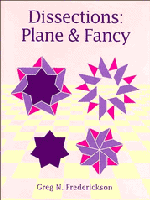Book contents
- Frontmatter
- Contents
- Preface
- 1 “Dat Pussle”
- 2 Our Geometric Universe
- 3 Fearful Symmetry
- 4 It's Hip to Be a Square
- 5 Triangles and Friends
- 6 All Polygons Created Equal
- 7 First Steps
- 8 Step Right Up!
- 9 Watch Your Step!
- 10 Just Tessellating
- 11 Plain Out-Stripped
- 12 Strips Teased
- 13 Tessellations Completed
- 14 Maltese Crosses
- 15 Curves Ahead
- 16 Stardom
- 17 Farewell, My Lindgren
- 18 The New Breed
- 19 When Polygons Aren't Regular
- 20 On to Solids
- 21 Cubes Rationalized
- 22 Prisms Reformed
- 23 Cheated, Bamboozled, and Hornswoggled
- 24 Solutions to All Our Problems
- Afterword
- Bibliography
- Index of Dissections
- General Index
7 - First Steps
Published online by Cambridge University Press: 05 August 2012
- Frontmatter
- Contents
- Preface
- 1 “Dat Pussle”
- 2 Our Geometric Universe
- 3 Fearful Symmetry
- 4 It's Hip to Be a Square
- 5 Triangles and Friends
- 6 All Polygons Created Equal
- 7 First Steps
- 8 Step Right Up!
- 9 Watch Your Step!
- 10 Just Tessellating
- 11 Plain Out-Stripped
- 12 Strips Teased
- 13 Tessellations Completed
- 14 Maltese Crosses
- 15 Curves Ahead
- 16 Stardom
- 17 Farewell, My Lindgren
- 18 The New Breed
- 19 When Polygons Aren't Regular
- 20 On to Solids
- 21 Cubes Rationalized
- 22 Prisms Reformed
- 23 Cheated, Bamboozled, and Hornswoggled
- 24 Solutions to All Our Problems
- Afterword
- Bibliography
- Index of Dissections
- General Index
Summary
Down two levels in the sub-basement, the librarian unlocks first the door to the special collection and then the cabinet door. Retrieved from within is a substantial leather-bound volume, the third in the collected works of Girolamo Cardano, containing De Rerum Varietate. The thick pages are in good condition, sa ve for the bleedthrough of the print. The volume has survived for over three centuries, outlasting so many, many people. And before its printing in 1663, its contents had survived a century from their penning in 1557. Cached amidst a variety of things is an illustration of how to cut a (2a × 3b)-rectangle into just two pieces that rearrange into a (3a × 2b)-rectangle. The Latin text now obscures an explanation. Written by a man who embraced the then-new notion of shared knowledge, his contribution has endured to lie buried in a basement, locked within a room, within a cabinet, within a now-dead language.
The dissection Cardano (1663) described is an example of the step technique, so named because of the resemblance to stair steps. In its simplest form, the step technique cuts a rectangle in a zigzag pattern, alternating horizontal cuts of one length with vertical cuts of another. By shifting the two resulting pieces by one step relative to each other, we form a different rectangle. Figure 7.1 illustrates the case for converting a (3a × 4b)-rectangle to a (4a × 3b)-rectangle.
- Type
- Chapter
- Information
- DissectionsPlane and Fancy, pp. 60 - 70Publisher: Cambridge University PressPrint publication year: 1997



